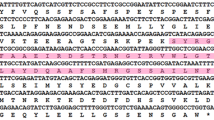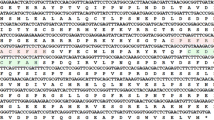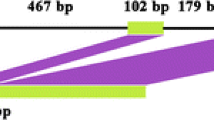Abstract
C3H-type zinc finger genes play diverse roles in plant growth, development, and stress responses. In our present study, a C3H-type gene namely BoC3H4 was isolated from broccoli. BoC3H4 was 1629 bp in length encoding 542 amino acid residues. The deduced protein sequence contained two ankyrin repeats and two CCCH zinc finger motifs, and those motifs shared high identities with homologous sequences from other Cruciferae plants. The expression levels of BoC3H4 elevated when subjected to both salt stress and Sclerotinia sclerotiorum infection. Broccoli plants with constitutive expression of BoC3H4 demonstrated increased tolerance toward salinity stress, accompanied by a prominent accumulation of proline, and a remarkable decrease of chlorophyll loss, MDA, REC, as well as H2O2 accumulation compared to WT plants. Moreover, over-expression of BoC3H4 in broccoli lines decreased resistance to S. sclerotiorum, and it could not induce the expression of BoPDF1.2 gene, the marker gene for JA/ET signaling pathway. Our study proposes that BoC3H4 acts as a positive regulator of plant tolerance to salinity stress and a negative regulator of resistance to necrotrophic pathogen S. sclerotiorum.









Similar content being viewed by others
Abbreviations
- SA:
-
Salicylic acid
- ET:
-
Ethylene
- MeJA:
-
Methyl jasmonate
- ABA:
-
Abscisic acid
- MDA:
-
Malonyldialdehyde
- NJ:
-
Neighbor-joining
- REC:
-
Relative electrical conductivity
- qRT-PCR:
-
Quantitative real-time polymerase chain reaction
- WT:
-
Wild-type
- CTAB:
-
Cetyltrimethylammonium bromide
- NBT:
-
Nitroblue tetrazolium
- DAB:
-
3,3′-Diaminobenzidine
- PR:
-
Pathogenesis related
- TF:
-
Transcription factors
- ZF:
-
Zinc finger
- ROS:
-
Reactive oxygen species
References
Arnon DI (1949) Copper enzymes in isolated chloroplasts. Polyphenoloxidase in Beta vulgaris. Plant Physiol 24:1–15
Ahmadi MR, Javan-Nik-Khah M, Aghajani MA, Ghobakhloo M (2012) Morphological variability among Sclerotinia sclerotiorum populations associated with stem rot of important crops and weeds. World Appl Sci J 20:1561–1564
Al-Khodor S, Price CT, Kalia A, Abu Kwaik Y (2010) Functional diversity of ankyrin repeats in microbial proteins. Trends Microbiol 18:132–139
Apel K, Hirt H (2004) Reactive oxygen species: metabolism, oxidative stress, and signal transduction. Annu Rev Plant Biol 55:373–399
Apostolova P, Yordanova R, Popova L (2008) Response of antioxidative defence system to low temperature stress in two wheat cultivars. Gen Appl Plant Physiol 34:281–294
Bates LS, Waldren RP, Teare ID (1973) Rapid determination of free proline for water stress studies. Plant Soil 39:205–207
Bogamuwa S, Jang JC (2013) The Arabidopsis tandem CCCH zinc finger proteins AtTZF4, 5 and 6 are involved in light-, abscisic acid- and gibberellic acid-mediated regulation of seed germination. Plant, Cell Environ 36:1507–1519
Bogamuwa SP, Jang JC (2014) Tandem CCCH zinc finger proteins in plant growth, development and stress response. Plant Cell Physiol 55:1367–1375
Boland GJ, Webster SJ, Walker L (1994) Index of plant hosts of Sclerotinia sclerotiorum. Can J Plant Pathol 16:93–108
Bueno EA, Oliveira MB, Andrade RV, Lobo M Jr, Petrofeza S (2012) Effect of different carbon sources on proteases secreted by the fungal pathogen Sclerotinia sclerotiorum during Phaseolus vulgaris infection. Genet Mol Res 11:2171–2181
Castro LH, Figueiró AA, Nogueira AP, Clough SJ, Juliatti FC (2016) Resistance of soybean genotypes to Sclerotinia sclerotiorum isolates in different incubation environments. Genet Mol Res 15:gmr15049061
Ciolkowski I, Wanke D, Birkenbihl RP, Somssich IE (2008) Studies on DNA-binding selectivity of WRKY transcription factors lend structural clues into WRKY-domain function. Plant Mol Biol 68:81–92
Clarkson JP, Fawcett L, Anthony SG (2014) A model for Sclerotinia sclerotiorum infection and disease development in lettuce, based on the effects of temperature, relative humidity and ascospore density. PLoS ONE 9:e94049
Del Rio D, Stewart AJ, Pellegrini N (2005) A review of recent studies on malondialdehyde as toxic molecule and biological marker of oxidative stress. Nutr Metab Cardiovasc Dis 15:316–328
Deng H, Liu H, Li X, Xiao J, Wang S (2012) A CCCH-type zinc finger nucleic acid-binding protein quantitatively confers resistance against rice bacterial blight disease. Plant Physiol 158:876–889
Doyle JJ, Doyle JL (1987) A rapid DNA isolation procedure for small quantities of fresh leaf tissue. Phytochem Bull 19:11–15
Duan Y, Jiang Y, Ye S, Karim A, Ling Z, He Y, Yang S, Luo K (2015) PtrWRKY73, a salicylic acid-inducible poplar WRKY transcription factor, is involved in disease resistance in Arabidopsis thaliana. Plant Cell Rep 34:831–841
Franco-Zorrilla JM, López-Vidriero I, Carrasco JL, Godoy M, Vera P, Solano R (2014) DNA-binding specificities of plant transcription factors and their potential to define target genes. Proc Natl Acad Sci USA 111(6):2367–2372
Guo ZJ, Chen XJ, Wu XL, Ling JQ, Xu P (2004) Overexpression of the AP2/EREBP transcription factor OPBP1 enhances disease resistance and salt tolerance in tobacco. Plant Mol Biol 55:607–618
Guo YH, Yu YP, Wang D, Wu CA, Yang GD, Huang JG, Zheng CC (2009) GhZFP1, a novel CCCH-type zinc finger protein from cotton, enhances salt stress tolerance and fungal disease resistance in transgenic tobacco by interacting with GZIRD21A and GZIPR5. New Phytol 183:62–75
Hassen A, Maher S, Cherif H (2014) Effect of salt stress (NaCl) on germination and early seedling parameters of three pepper cultivars (Capsicum annuum L.). J Stress Physiol Biochem 10:10–25
Hopper NW, Overholt JR, Martin JR (1979) Effect of cultivar, temperature and seed size on the germination and emergence of soya beans (Glycine max (L.) Merr.). Ann Bot 44:301–308
Huang Z, Zhao L, Chen D, Liang M, Liu Z, Shao H, Long X (2013) Salt stress encourages proline accumulation by regulating proline biosynthesis and degradation in Jerusalem artichoke plantlets. PLoS ONE 8:e62085
Hussain SS, Kayani MA, Amjad M (2011) Transcription factors as tools to engineer enhanced drought stress tolerance in plants. Biotechnol Progr 27:297–306
Hwang JH, Lim SB (2015) Antioxidant and anticancer activities of broccoli by-products from different cultivars and maturity stages at harvest. Prev Nutr Food Sci 20:8–14
Jan A, Maruyama K, Todaka D, Kidokoro S, Abo M, Yoshimura E, Shinozaki K, Nakashima K, Yamaguchi-Shinozaki K (2013) OsTZF1, a CCCH-tandem zinc finger protein, confers delayed senescence and stress tolerance in rice by regulating stress-related genes. Plant Physiol 161:1202–1216
Jiang M, Miao LX, He CM (2012) Overexpression of an oil radish superoxide dismutase gene in broccoli confers resistance to downy mildew. Plant Mol Biol Rep 30:966–972
Jiang M, Jiang JJ, Miao LX, He CM (2017) Over-expression of a C3H-type zinc finger gene contributes to salt stress tolerance in transgenic broccoli plants. Plant Cell Tissue Org 130(2):239–254
Kuhlmann F, Müller C (2009) Independent responses to ultraviolet radiation and herbivore attack in broccoli. J Exp Bot 60:3467–3475
Kumar P, Srivastava DK (2015) High frequency organogenesis in hypocotyl, cotyledon, leaf and petiole explants of broccoli (Brassica oleracea L. var. italica), an important vegetable crop. Physiol Mol Biol Plants 21:279–285
Kumar P, Srivastava DK (2016) Biotechnological advancement in genetic improvement of broccoli (Brassica oleracea L. var. italica), an important vegetable crop. Biotechnol Lett 38:1049–1063
Kumar S, Tamura K, Nei M (2004) MEGA3: integrated software for molecular evolutionary genetics analysis and sequence alignment. Brief Bioinform 5:150–163
Kumar D, Yusuf MA, Singh P, Sardar M, Sarin NB (2014) Histochemical detection of superoxide and H2O2 accumulation in Brassica juncea seedlings. Bio-protocol 4:e1108
Kushad MM, Brown AF, Kurilich AC, Juvik JA, Klein BP, Wallig MA, Jeffery EH (1999) Variation of glucosinolates in vegetable crops of Brassica oleracea. J Agric Food Chem 47:1541–1548
Li J, Mahajan A, Tsai MD (2006) Ankyrin repeat: a unique motif mediating protein-protein interactions. Biochemistry 45:15168–15178
Lim CW, Baek W, Lim S, Han SW, Lee SC (2015) Expression and functional roles of the pepper pathogen-induced bZIP transcription factor CabZIP2 in enhanced disease resistance to bacterial pathogen infection. Mol Plant Microbe Interact 28:825–833
Liu B, Ouyang Z, Zhang Y, Li X, Hong Y, Huang L, Liu S, Zhang H, Li D, Song F (2014a) Tomato NAC transcription factor SlSRN1 positively regulates defense response against biotic stress but negatively regulates abiotic stress response. PLoS ONE 9:e102067
Liu S, Khan MR, Li Y, Zhang J, Hu C (2014b) Comprehensive analysis of CCCH-type zinc finger gene family in citrus (Clementine mandarin) by genome-wide characterization. Mol Genet Genomics 289:855–872
Liu X, Song Y, Xing F, Wang N, Wen F, Zhu C (2016) GhWRKY25, a group I WRKY gene from cotton, confers differential tolerance to abiotic and biotic stresses in transgenic Nicotiana benthamiana. Protoplasma 253:1265–1281
Livak KJ, Schmittgen TG (2001) Analysis of relative gene expression data using real-time quantitative PCR and the 2−ΔΔCT method. Methods 25:402–408
Mahn A, Reyes A (2012) An overview of health-promoting compounds of broccoli (Brassica oleracea var. italica) and the effect of processing. Food Sci Technol Int 18:503–514
Mosavi LK, Cammett TJ, Desrosiers DC, Peng ZY (2004) The ankyrin repeat as molecular architecture for protein recognition. Protein Sci 13:1435–1448
Nuruzzaman M, Sharoni AM, Kikuchi S (2013) Roles of NAC transcription factors in the regulation of biotic and abiotic stress responses in plants. Front Microbiol 4:248
Peng X, Zhao Y, Cao J, Zhang W, Jiang H, Li X, Ma Q, Zhu S, Cheng B (2012) CCCH-Type zinc finger family in maize: genome-wide identification, classification and expression profiling under abscisic acid and drought treatments. PLoS ONE 7:e40120
Pogany M, von Rad U, Grun S, Dongo A, Pintye A, Simoneau P, Bahnweg G, Kiss L, Barna B, Durner J (2009) Dual roles of reactive oxygen species and NADPH oxidase RBOHD in an Arabidopsis-Alternaria pathosystem. Plant Physiol 151:1459–1475
Pradhan S, Kant C, Verma S, Bhatia S (2017) Genome-wide analysis of the CCCH zinc finger family identifies tissue specific and stress responsive candidates in chickpea (Cicer arietinum L.). PLoS ONE 12:e0180469
Qiu A, Lei Y, Yang S, Wu J, Li J, Bao B, Cai Y, Wang S, Lin J, Wang Y, Shen L, Cai J, Guan D, He S (2018) CaC3H14 encoding a tandem CCCH zinc finger protein is directly targeted by CaWRKY40 and positively regulates the response of pepper to inoculation by Ralstonia solanacearum. Mol Plant Pathol 19:2221–2235
Rahman MU, Kayani SA, Shereen G (2000) Combined effects of temperature and salinity stress on corn cv. sunahry. Pak J Biol Sci 3:1459–1463
Ramachandran S, Hiratsuka K, Chua NH (1994) Transcription factors in plant growth and development. Curr Opin Genet Dev 4:642–646
Saher S, Piqueras A, Hellin E, Olmos E (2004) Hyperhydricity in micropropaged carnation shoots: the role of oxidative stress. Physiol Planta 120:152–161
Sasaki-Sekimoto Y, Saito H, Masuda S, Shirasu K, Ohta H (2014) Comprehensive analysis of protein interactions between JAZ proteins and bHLH transcription factors that negatively regulate jasmonate signaling. Plant Signal Behav 9:e27639
Schieber M, Chandel NS (2014) ROS function in redox signaling and oxidative stress. Curr Biol 24:R453–R462
Sergiev I, Alexieva V, Karanov E (1997) Effect of spermine, atrazine and combination between them on some endogenous protective systems and stress markers in plants. Compt Rend Acad Bulg Sci 51:121–124
Shahbaz M, Ashraf M, Akram NA, Hanif A, Hameed S, Joham S, Rehman R (2011) Salt-induced modulation in growth, photosynthetic capacity, proline content and ion accumulation in sunflower (Helianthus annuus L.). Acta Physiol Plant 33:1113–1122
Thompson JD, Gibson TJ, Plewniak F, Jeanmougin F, Higgins DG (1997) The CLUSTAL_X windows interface: flexible strategies for multiple sequence alignment aided by quality analysis tools. Nucleic Acids Res 25:4876–4882
Tsuda K, Somssich IE (2015) Transcriptional networks in plant immunity. New Phytol 206:932–947
Uloth MB, Clode PL, You MP, Barbetti MJ (2016) Attack modes and defence reactions in pathosystems involving Sclerotinia sclerotiorum, Brassica carinata, B. juncea and B. napus. Ann Bot 117:79–95
Vom Endt D, Kijne JW, Memelink J (2002) Transcription factors controlling plant secondary metabolism: what regulates the regulators? Phytochemistry 61:107–114
Wang D, Guo Y, Wu C, Yang G, Li Y, Zheng C (2008) Genome-wide analysis of CCCH zinc finger family in Arabidopsis and rice. BMC Genomics 9:44
Wang M, Wang Y, Sun J, Ding M, Deng S, Hou P, Ma X, Zhang Y, Wang F, Sa G, Tan Y, Lang T, Li J, Shen X, Chen S (2013) Overexpression of PeHA1 enhances hydrogen peroxide signaling in salt-stressed Arabidopsis. Plant Physiol Biochem 71:37–48
Wang W, Liu B, Xu M, Jamil M, Wang G (2015) ABA-induced CCCH tandem zinc finger protein OsC3H47 decreases ABA sensitivity and promotes drought tolerance in Oryza sativa. Biochem Biophys Res Commun 464:33–37
Wang H, Wang H, Shao H, Tang X (2016) Recent advances in utilizing transcription factors to improve plant abiotic stress tolerance by transgenic technology. Front Plant Sci 7:67
Wilkins MR, Gasteiger E, Bairoch A, Sanchez JC, Williams KL, Appel RD, Hochstrasser DF (1999) Protein identification and analysis tools in the ExPASy server. Methods Mol Biol 112:531–552
Xu R (2014) Genome-wide analysis and identification of stress-responsive genes of the CCCH zinc finger family in Solanum lycopersicum. Mol Genet Genomics 289:965–979
Zabaras D, Roohani M, Krishnamurthy R, Cochet M, Delahunty CM (2013) Characterisation of taste-active extracts from raw Brassica oleracea vegetables. Food Funct 4:592–601
Zhang C, Zhang H, Zhao Y, Jiang H, Zhu S, Cheng B, Xiang Y (2013) Genome-wide analysis of the CCCH zinc finger gene family in Medicago truncatula. Plant Cell Rep 32:1543–1555
Acknowledgements
This work was supported by Taizhou Science and Technology Project (1901ny08), Science Foundation for Distinguished Young Scholars of Taizhou University (2017JQ001), and Zhejiang Provincial Natural Science Foundation of China (LY19C150004).
Author information
Authors and Affiliations
Contributions
MJ and LM conceived and designed the work. MJ, HZ, LM, and XZ performed the experiments. MJ analyzed the data and wrote the paper. All authors have read and approved the manuscript.
Corresponding author
Ethics declarations
Conflict of interest
The authors have no conflict of interest.
Additional information
Publisher's Note
Springer Nature remains neutral with regard to jurisdictional claims in published maps and institutional affiliations.
Rights and permissions
About this article
Cite this article
Jiang, M., Miao, L., Zhang, H. et al. Over-Expression of a Transcription Factor Gene BoC3H4 Enhances Salt Stress Tolerance but Reduces Sclerotinia Stem Rot Disease Resistance in Broccoli. J Plant Growth Regul 39, 1162–1176 (2020). https://doi.org/10.1007/s00344-019-10054-7
Received:
Accepted:
Published:
Issue Date:
DOI: https://doi.org/10.1007/s00344-019-10054-7




